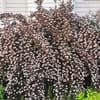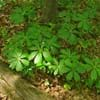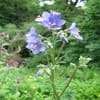Life Span
Perennial
Perennial
Origin
Not Available
North America, United States, Northeastern United States, Mid-Atlantic United States, Southeastern United States, South-Central United States, Texas, Canada
Types
Center Glow ninebark,
Coppertina ninebark, Little Devil ninebark
not available
Habitat
Cliffs, hedge rows, rocky banks of streams, sandy seeps, Wooded hillsides
Mixed deciduous forest, shaded fields, shaded moist road banks, shaded riverbanks
USDA Hardiness Zone
3-8
3-9
Sunset Zone
A1, A2, A3, H1, H2, 1a, 1b, 2a, 2b, 3a, 3b, 4, 5, 6, 7, 8, 9, 10, 11, 12, 13, 14, 15, 16, 17, 18, 19, 20, 21, 22, 23, 24
1a, 1b, 2a, 2b, 3a, 3b, 4, 5, 6, 7
Habit
Not Available
Clump-Forming
Minimum Height
Not Available
Flower Color
Not Available
White, Light Pink
Flower Color Modifier
Not Available
Not Available
Fruit Color
Not Available
Yellow
Leaf Color in Spring
Not Available
Green
Leaf Color in Summer
Not Available
Green
Leaf Color in Fall
Not Available
Green
Leaf Color in Winter
Light Green
Light Green
Leaf Shape
Palmate
Palmate
Plant Season
Not Available
Spring, Summer, Fall
Sunlight
Full Sun, Partial Sun
Partial shade, Full Shade
Growth Rate
Not Available
Medium
Type of Soil
Not Available
Clay, Loam
The pH of Soil
Not Available
Acidic, Neutral
Soil Drainage
Not Available
Average
Bloom Time
Summer, Late Summer, Early Fall
Early Spring, Spring
Repeat Bloomer
Not Available
No
Tolerances
Drought
Drought
Where to Plant?
Ground, Pot
Ground, Pot
How to Plant?
Layering, Stem Planting
Root Division, Seedlings
Plant Maintenance
Medium
Medium
Watering Requirements
Requires watering in the growing season, Water Deeply
Do Not over Water, Requires regular watering
In Summer
Moderate
Lots of watering
In Spring
Average Water
Moderate
In Winter
Adequately
Average Water
Soil pH
Not Available
Acidic, Neutral
Soil Type
Not Available
Clay, Loam
Soil Drainage Capacity
Not Available
Average
Sun Exposure
Full Sun, Partial Sun
Partial shade, Full Shade
Pruning
Remove damaged leaves, Remove dead branches
Remove damaged leaves, Remove dead branches, Remove dead leaves
Fertilizers
Fertilize every year
All-Purpose Liquid Fertilizer
Pests and Diseases
Aphids, Powdery mildew, Red blotch
Pest Free, Red blotch
Plant Tolerance
Drought
Drought
Flowers
Not Available
Showy
Flower Petal Number
Not Available
Single
Showy Fruit
Not Available
Yes
Edible Fruit
Not Available
Yes
Fragrant Flower
Not Available
Yes
Fragrant Fruit
Not Available
No
Fragrant Leaf
Not Available
No
Fragrant Bark/Stem
Not Available
No
Showy Foliage
Not Available
Yes
Showy Bark
Not Available
No
Foliage Texture
Not Available
Coarse
Foliage Sheen
Not Available
Glossy
Invasive
Not Available
No
Self-Sowing
Not Available
Yes
Attracts
Not Available
Not Available
Allergy
Not Available
Toxic
Aesthetic Uses
Showy Purposes
Showy Purposes
Beauty Benefits
No Beauty Benefits
Not Available
Environmental Uses
Air purification
Air purification
Medicinal Uses
Emetic, Laxative, Woman infertility
antihelmintic, cathartic, Emetic, malignant neoplasms, Stomach pain
Part of Plant Used
Whole plant
Rhizomes, Root
Other Uses
Used as Ornamental plant, Used for its medicinal properties
Used as Ornamental plant, Used for its medicinal properties
Used As Indoor Plant
No
No
Used As Outdoor Plant
Yes
Yes
Garden Design
Not Available
Edible, Feature Plant, Groundcover, Wildflower
Botanical Name
PHYSOCARPUS
PODOPHYLLUM peltatum
Common Name
Ninebark
American Mandrake, Mayapple
In Hindi
Ninebark
अमेरिकी विषैला पौधा
In German
Ninebark
amerikanisch Alraune
In French
Physocarpe
mandrake américain
In Spanish
ninebark
mandrágora americana
In Greek
ninebark
american μανδραγόρα
In Portuguese
ninebark
mandrake americano
In Polish
Ninebark
amerykański mandragory
In Latin
Ninebark
Latin mandragoras
Phylum
Magnoliophyta
Magnoliophyta
Class
Magnoliopsida
Magnoliopsida
Order
Rosales
Ranunculales
Family
Rosaceae
Berberidaceae
Genus
Physocarpus
Podophyllum
Clade
Angiosperms, Eudicots, Rosids
Angiosperms, Eudicots
Tribe
Neillieae
Not Available
Subfamily
Amygdaloideae
Not Available
Number of Species
Not Available
Season and Care of Ninebark and Mayapple
Season and care of Ninebark and Mayapple is important to know. While considering everything about Ninebark and Mayapple Care, growing season is an essential factor. Ninebark season is Not Available and Mayapple season is Not Available. The type of soil for Ninebark is Not Available and for Mayapple is Clay, Loam while the PH of soil for Ninebark is Not Available and for Mayapple is Acidic, Neutral.
Ninebark and Mayapple Physical Information
Ninebark and Mayapple physical information is very important for comparison. Ninebark height is Not Available and width Not Available whereas Mayapple height is 30.50 cm and width Not Available. The color specification of Ninebark and Mayapple are as follows:
Ninebark flower color: Not Available
Ninebark leaf color: Not Available
Mayapple flower color: White and Light Pink
- Mayapple leaf color: Green
Care of Ninebark and Mayapple
Care of Ninebark and Mayapple include pruning, fertilizers, watering etc. Ninebark pruning is done Remove damaged leaves and Remove dead branches and Mayapple pruning is done Remove damaged leaves, Remove dead branches and Remove dead leaves. In summer Ninebark needs Moderate and in winter, it needs Adequately. Whereas, in summer Mayapple needs Lots of watering and in winter, it needs Average Water.





